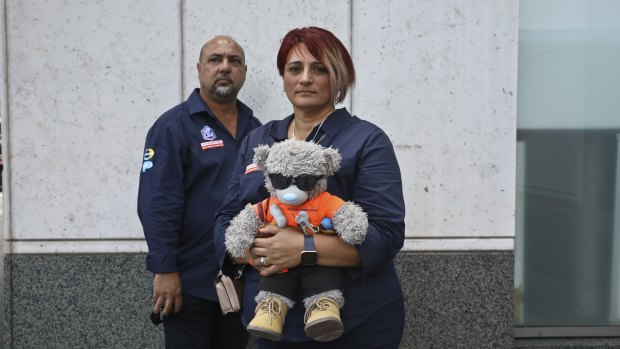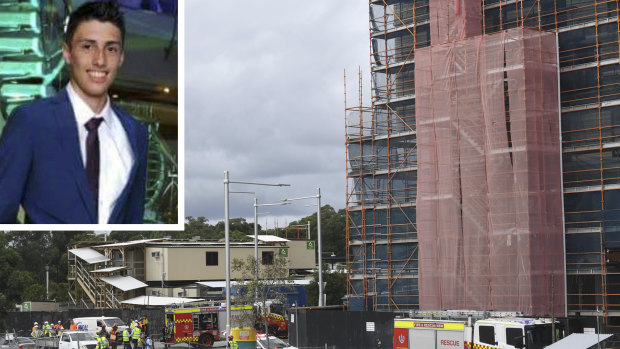This was published 3 years ago
Worksite risk so high that apprentice’s death ‘was almost certain’, court finds
By Lucy Cormack
A judge has found the risk of death on a north-west Sydney construction site was so great “it was almost certain,” when an 18-year-old sub-contractor was killed in a catastrophic incident last year.
Apprentice formworker Christopher Cassaniti was crushed when overloaded scaffolding collapsed at a Macquarie Park worksite last April. A co-worker also suffered serious injuries.
It was later discovered that ties should have secured the scaffolding to the building but had been removed.

Rob and Patrizia Cassaniti, parents of Christopher Cassaniti who was killed in a workplace incident in 2019,Credit: Ben Rushton
Ganellen, the managing contractor at the Lachlans Line development site, was fined $1.2 million on Thursday, before a 25 per cent discount after pleading guilty to failing to comply with health and safety duties.
The verdict has renewed calls for industrial manslaughter laws to provide greater protection for workers in the construction industry.
NSW District Court Judge Andrew Scotting found Ganellen had failed to check building load weights, scaffolding ties and structures, amounting to an offence of the "utmost objective gravity."
"In the circumstances where the scaffold was overloaded and the ties to the building had been removed, the likelihood of risk occurring was so high that it was almost certain," he said.

Christopher Cassaniti (centre) celebrating his 18th birthday with his family.
Judge Scotting said the hoist had been overloaded deliberately to make use of it before its planned removal, and said the site had a history of ties “being tampered with and removed.”
Ganellen must also contribute a further $104,000 and establish a working group to deliver a scaffolding industry safety standard over the next 12 months.
A Ganellen spokesman said the company took responsibility for the 18-year-old's death and would not be appealing.

Christopher Cassaniti, 18, died after scaffolding collapsed at a Macquarie Park in April 2019.Credit: Peter Braig
Mr Cassaniti's mother Patrizia read a harrowing victim impact statement to the court, describing her son's final 20 minutes trapped under rubble before he ran out of oxygen.
"The grief that I feel is only the start because Christopher now lives only in my heart. I treasure each picture, because that is all I have to cling to memories that I thought I forgot," Mrs Cassaniti said.

Mr Cassaniti was an apprentice formworker who was subcontracted to the site in Sydney's north west where he was killed.
There are three categories of offences for breaches of a health and safety duty. The most serious category one incidents now attract a maximum penalty of almost $3.5 million for a corporation and $300,000 and/or five years imprisonment for an individual.
Mr Cassaniti’s death was deemed a lesser category two incident, which results in a maximum penalty of $1.73 million for a corporation and $150,000 for an individual.
“The outcome doesn’t match the crime. The NSW penalties aren’t strong enough to deter a builder from allowing unsafe work practice. Why aren’t we leading all the other states?” Mrs Cassaniti said.
Under new Victorian industrial manslaughter laws a person or employer that negligently causes a workplace death faces a fine of up to $16.5 million, and 20 years jail for individuals.
In Queensland, similar penalties stretch to $10 million for a body corporate and $600,000 or five years imprisonment for an individual.
NSW Labor proposed an industrial manslaughter offence in December last year, following a spate of workplace fatalities and injuries. The proposed laws were taken to the upper house in March but defeated by one vote.
Labor leader in the Legislative Council and Shadow Minister for Industrial Relations Adam Searle said he intended to take the issue back to the upper house when parliament resumes next year.
Mr Searle accused Safework of "dropping the ball" on the number of prosecutions it brings, in comments echoed by CFMEU NSW Secretary Darren Greenfield.
“As a regulator, Safework NSW has vacated the space when it comes to investigating and prosecuting breaches of safety laws and is not up to the job of holding employers to account,” Mr Greenfield said.
A SafeWork NSW spokesman said it did not comment on the rationale for the charges it commences.
Minister for Better Relation Kevin Anderson said legislation introduced in April had made it easier to prosecute businesses for putting workers at risk of serious injury or death, "before [an] incident."
Mrs Cassaniti is now a safety advocate and keynote speaker and said she hopes to contribute to the scaffolding industry standards working group.